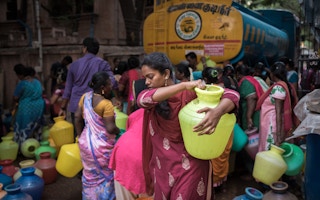One year ago, Chennai suffered a historic drought. For nearly 200 days, the metropolis of 7 million people facing the Bay of Bengal in eastern India went without a drop of rain, pushing it to breaking point. Already strained by a burgeoning population, water supply eventually hit rock bottom, upending the economy and the lives of the city’s residents.
To continue reading, subscribe to Eco‑Business.
There's something for everyone. We offer a range of subscription plans.
- Access our stories and receive our Insights Weekly newsletter with the free EB Member plan.
- Unlock unlimited access to our content and archive with EB Circle.
- Publish your content with EB Premium.
As families across Chennai struggled to find water to wash, cook and keep businesses afloat, the state of Tamil Nadu came under fire for failing to prepare for and deal with the crippling shortage. More than the caprice of nature, the disaster was seen as proof that authorities had allowed India’s sixth-largest city to overstretch itself as it expanded.
This year, Chennai has been given a respite from its water woes. But rather than administrative efforts, it is nature that has offered the biggest relief. Last September, Tamil Nadu’s northern neighbour Andhra Pradesh resumed transferring water to the water-deficient city, having previously shut the sluice gates of its Kandaleru reservoir, citing its irrigation needs. Meanwhile, the current summer monsoon has brought bountiful rainfall.
With last year’s images of women fighting over water in drought-stricken neighbourhoods still fresh in the memory, has Chennai begun facing up to its water problems to prevent a repeat of the crisis?
Development derailed
Water issues have plagued Chennai for years. The city depends on the northeast monsoon to replenish its lakes and aquifers during the winter months. But the rains delivered by the moisture-laden winds that sweep down from the Himalayas and across the Bay of Bengal have become increasingly unpredictable. Some years they are fickle, only to lash the metropolis in others.
Prolonged dry spells and torrential downpours used to be less of an issue. But gone are most of Chennai’s lakes that once soaked up the rains and saved them for lean times. They have been built over as the metropolis grew. Those that remain and the city’s rivers are clogged with waste, industrial chemicals and construction debris.
So thoroughly has Chennai’s concrete jungle swallowed up fallow land that water now barely finds soil to seep into. Persistent pumping means groundwater levels have fallen sharply. “The city has lost its ability to capture rainwater, and that’s because of unplanned and unregulated urbanisation,” said Krishna Mohan Ramachandran, chief resilience officer at non-profit 100 Resilient Cities in Chennai.
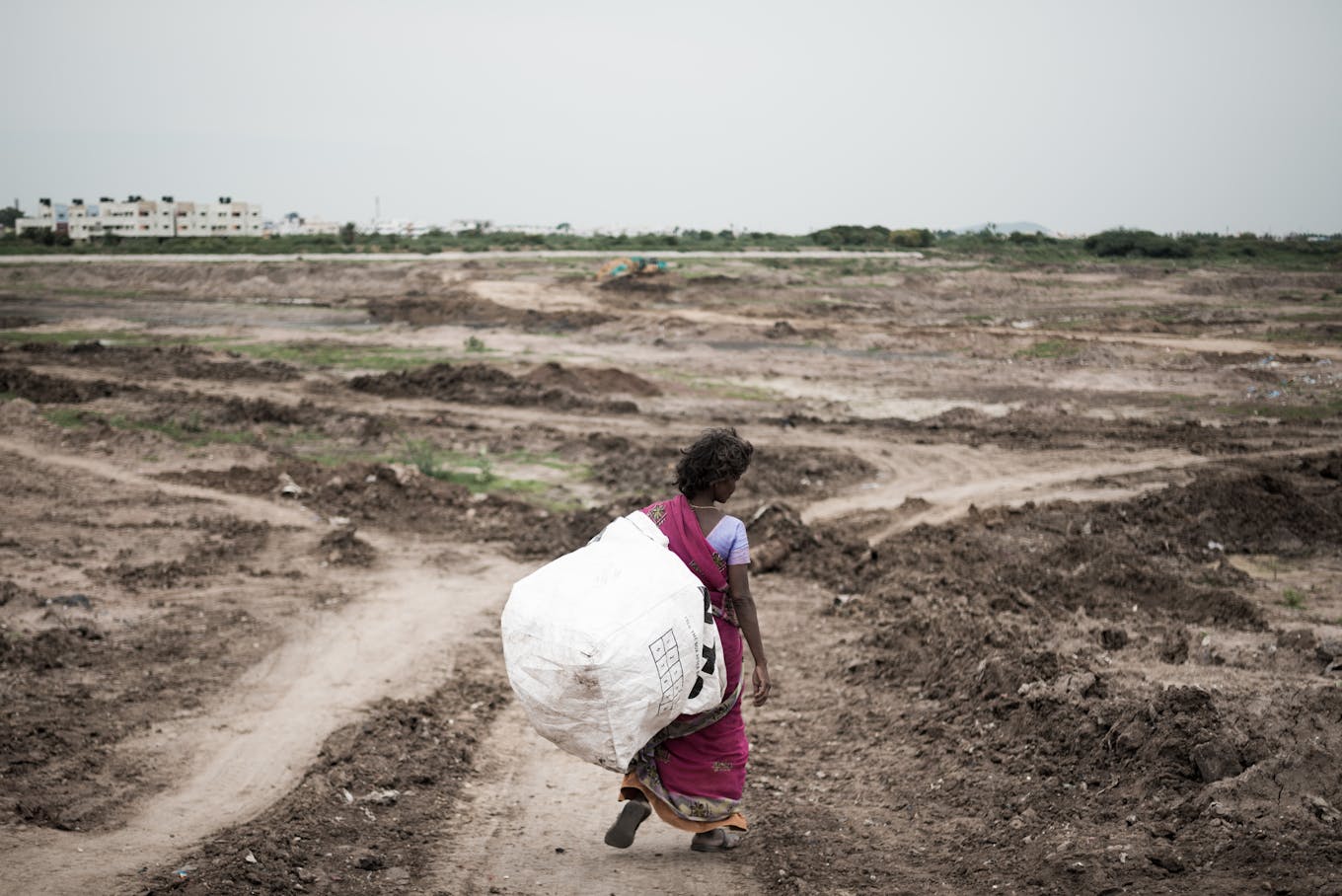
A woman wanders into dried-up Narayanapuram Lake to collect waste to be sold in the scrap market in July 2019. Many of Chennai’s reservoirs have been paved over or left unmaintained for decades, eroding the city’s ability to capture precious rains. Image: Tim Ha, Eco-Business
Rampant construction has not been the only lapse in Chennai’s development. Heavy rains and the destruction they have wrought have elicited louder public outcries, prompting city-planners to place flood mitigation rather than water conservation front and centre. Over the years, an extensive drainage network has been built that takes stormwater off the roads fast and transfers it straight to the sea. Precious freshwater, experts say, is therefore lost.
“Floods get more attention. After three days of rain, you have residents up in arms, asking why the city is flooded, whereas droughts are a silent killer,” said Ramachandran. “We have yet to recognise that we are a more drought-prone city than a flood-prone one.”
“
We have yet to recognise that we are a more drought-prone city than a flood-prone one.
Krishna Mohan Ramachandran, chief resilience officer, Chennai, 100 Resilient Cities
Another issue is the city’s poor understanding of its water resources, said Dr Jayshree Vencatesan, managing trustee at research organisation Care Earth Trust in Chennai. “If you ask people in Chennai how many reservoirs there are in the city, you will be given numbers ranging from 30 to 3,000. If nobody has a handle on how many water bodies there are, how can we assume those reservoirs are intact and not encroached upon and disappearing?”
Chennai’s reservoirs were originally built to supply drinking water to demarcated areas. But since Indian independence, they have been connected through channels and pipes that crisscross the city, creating haphazard flow patterns that are difficult to monitor and manage. “Water moves all over the city in all kinds of directions and no one knows how or where to intervene,” Vencatesan told Eco-Business.
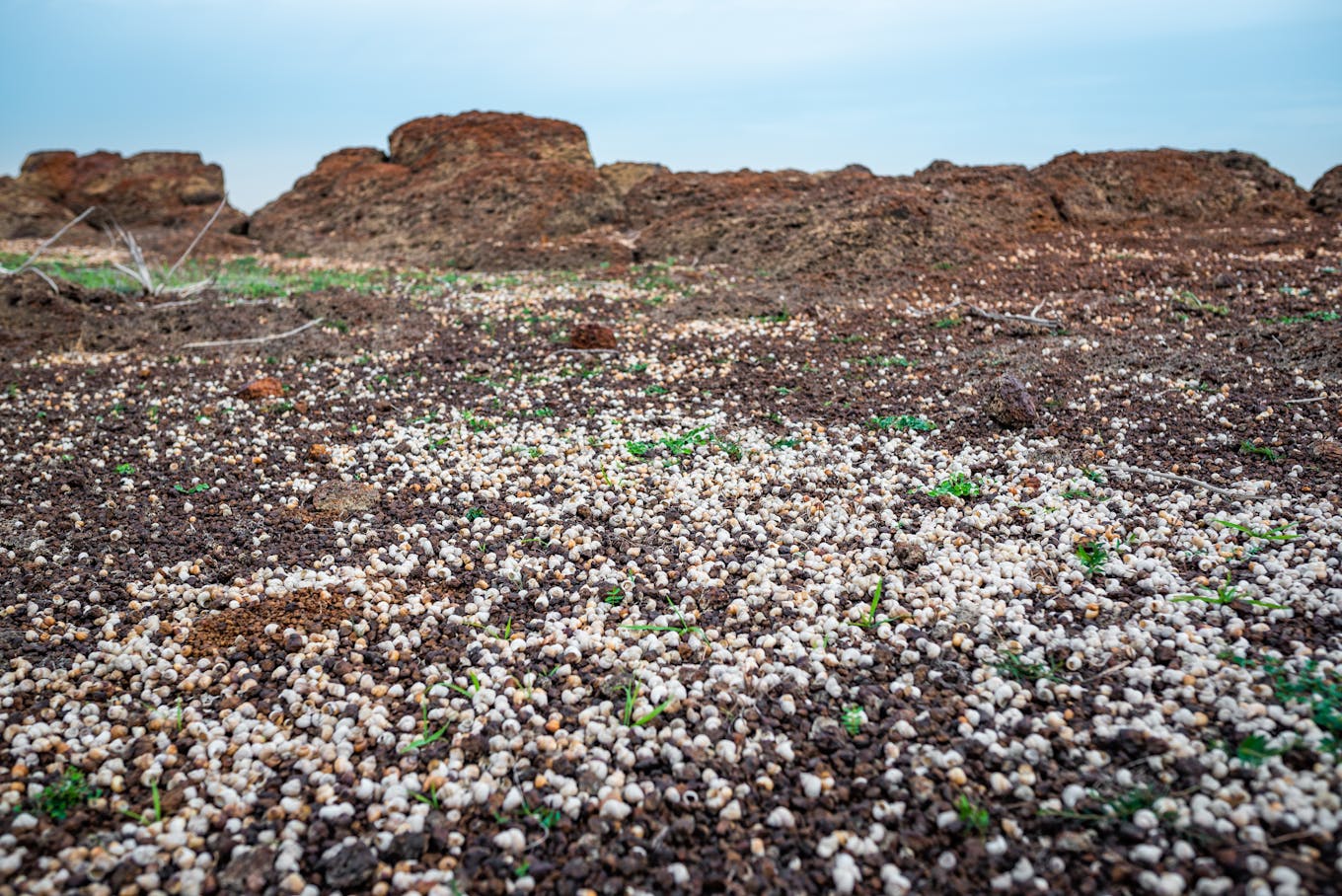
Puzhal Lake, one of Chennai’s four main reservoirs that supply the bulk of the city’s drinking water, lies barren and empty in August last year, its lakebed strewed with the shells of freshwater snails. Image: Tim Ha, Eco-Business
Beyond scarcity
What makes Chennai’s water problems so tough to resolve is also the multifaceted complexities that permeate them. The crisis has not only brought inequalities within the city and the wider Tamil Nadu region to the fore but widened them. Conversely, marginalisation of disadvantaged communities has amplified some of the city’s challenges.
Where informal settlers have erected their ramshackle huts near water bodies, the lack of wastewater treatment facilities has meant these groups have contributed to the city’s pollution problems. Often, this has led to slum-dwellers being scapegoated.
Meanwhile, unreliable supply has given rise to a shadow economy. At the height of last year’s crisis, the city dispatched more than 9,000 tankers each day to ship water from its outskirts to drought-stricken neighbourhoods, but even that was not enough. Private firms had to step in to supply another 5,000 trucks. This year, much of Chennai continues to rely on distant water sources.
Amid erratic weather and plummeting profits, many farming communities dotting the city’s periphery struggle to make ends meet, and many lease out their borewells to boost incomes. Often, no cap is placed on how much companies can extract, virtually letting them suck groundwater dry.
As the informal market thrives, it heightens tensions in villages exploited by ruthless water traders. Resentful that their precious water supplies hotels and shopping malls, these communities have confronted both water companies and authorities. “Villagers are worried their water is being sold to the city. Protests are still happening on the outskirts,” said Vencatesan.

A plot of land in Bangarampetta village fitted with several borewells. The property was bought by a businessman for the sole purpose of selling groundwater, according to residents. Fresh tire tracks mark where water trucks stop at night to fill up their tanks. Image: Tim Ha, Eco-Business
Bangarampetta, 30 kilometres west of the city, is one of the villages affected. Water traders and bottling companies began buying land in the area a decade ago. They draw water from levels deeper than individual farmers can drill, leaving little for the community.
“
If they take all our water, what will become of our village?
Jeeva Indharani, resident, Bangarampetta
Last year, the village filed a police report, urging authorities to safeguard their rights. When no response came, residents took matters into their own hands. In June, they seized a truck and demanded that their resources be protected before its release. But despite promises that the matter would be resolved, companies simply resorted to sending drivers in at night.
As their water vanishes, families struggle to irrigate crops and feed livestock. “If they take all our water, what will become of our village?” Jeeva Indharani, a local mechanic, said last August.
It is a fate facing many across the state. In Ambalur, a small village a three-hour train ride west of Chennai, most farmers have abandoned their homes amid acute water scarcity, uprooting themselves in search of somewhere else to live. Those who remain fear for their livelihoods as nearby towns eye their water resources.
Among them is Vanyambadi. Since the local leather production industry started pumping toxic effluents into Palar River, the rapidly expanding town has been sending trucks to collect groundwater in villages upstream.
“Vanyambadi is too polluted for its people to get drinking water there, so they come to us,” said J. K. Jamunar, a former history professor who has retired to her farm in Ambalur. “The city has ruined our farmers. Agriculture is dying.”

A stream in Vanyambadi, which connects to Palar River, is polluted with waste and toxic chemicals from local tannery firms. Image: Tim Ha, Eco-Business
When rural areas suffer at the hands of urban dwellers, cities place themselves on a slippery slope, G. Bhaskaran, head of the department for water resource management and associate professor at the department of geography at the University of Madras in Chennai, told Eco-Business last year.
“It is a dangerous trend. Water is brought into the city to support urban dwellers, but that has ramifications in rural areas,” he said. “Food production on Chennai’s outskirts is failing. When there is no agriculture left, there will be food shortages, and that means food prices will shoot up.”
Farmer suicides are already a common occurrence, he continued. Farmers tend to take heavy loans to buy seeds for sowing and some take their lives when their crops wither and they are unable to pay their lenders. As more families abandon their fields and turn to water trade, they encourage others to follow suit, locking rural communities into a vicious cycle.
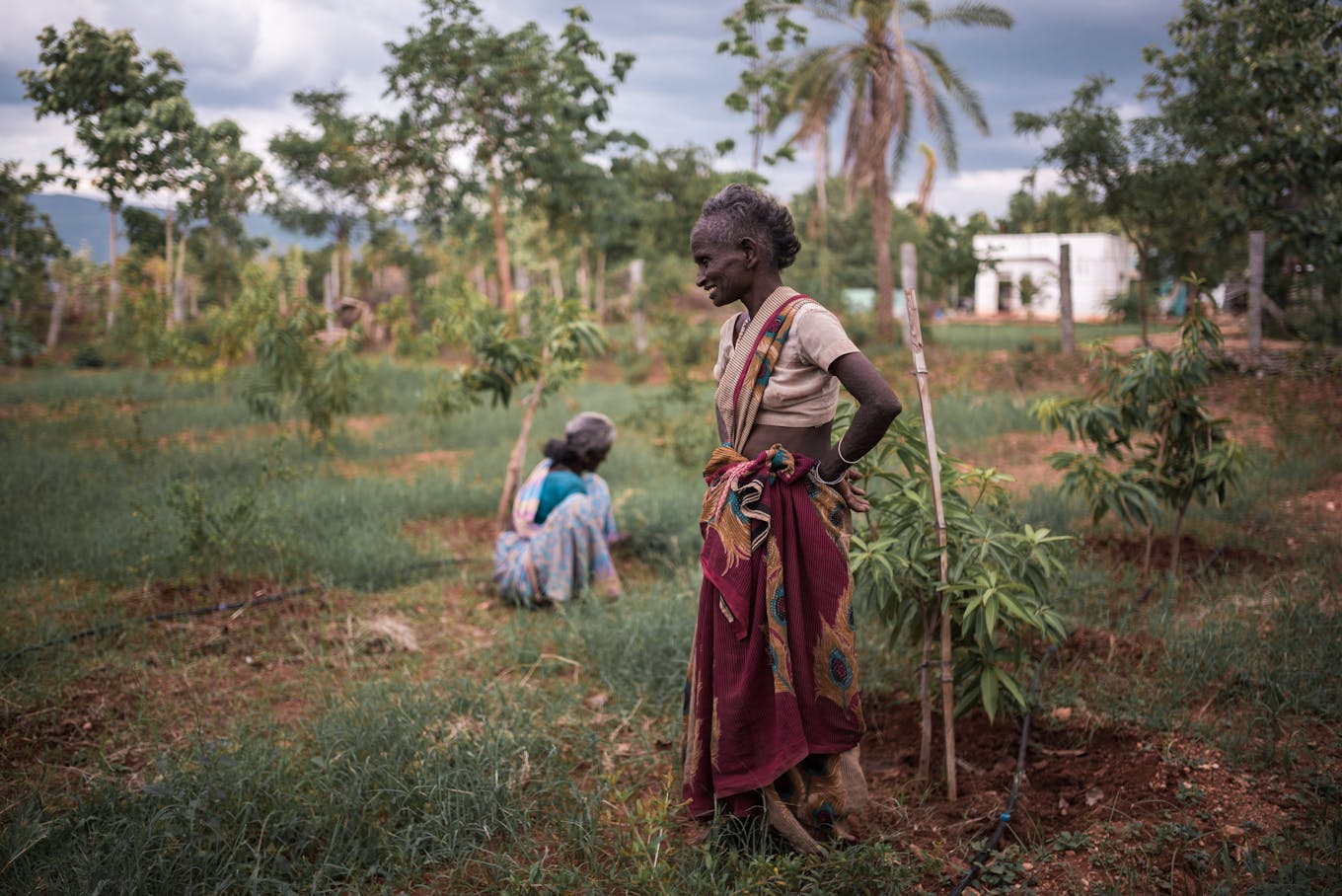
Two farm workers tend to the orchard on J. K. Jamunar’s farm in Ambalur. With aquifers depleted, Jamunar relies on expensive water that the municipality provides. Image: Tim Ha, Eco-Business
Decades in the making
Since last year, Chennai has taken myriad steps to ensure steady and reliable water supply. One of them is speeding up efforts to add more water bodies to its four main reservoirs. That way, the city hopes to better store water that Andhra Pradesh dispatches to the drought-stricken region.
In Tiruvallur district, Chennai is building a fifth reservoir with a storage volume of more than 28 billion litres. The project has faced multiple delays since construction works kicked off two years ago, but the government already looks to build yet another water body in Thiruperumputhur, a town on the city’s south-western outskirts.
To meet growing water demand, Chennai has also spent huge amounts of money to churn seawater through expensive desalination plants to convert it into drinking water. It already has two plants in operation, which meet about 20 per cent of the city’s needs, and plans to commission a third project by 2021.
“
We must increase the city’s sponge effect so that we can hold our rainwater, conserve it and manage it better. If we do that, we could reduce our reliance on desalination plants.
Krishna Mohan Ramachandran, chief resilience officer, Chennai, 100 Resilient Cities
Such endeavours notwithstanding, Chennai’s has yet to muster the political will to tackle some of its biggest challenges. The question is, how quickly can a problem be tackled that has been decades in the making?
Desalination seems a quick, easy fix to a complex issue, but environmentalists have pointed out catches. Not only do these plants devour immense amounts of capital and energy, they also release wastewater that wreaks havoc on marine life. The new plant carries a price tag of about $174 million.
Ramachandran said the city gets enough water from the short, heavy monsoon rains. It’s just that it does a poor job of capturing it. “The water goes straight to the sea, and then we spend millions pulling it back into the city. We must increase the city’s sponge effect so that we can hold our rainwater, conserve it and manage it better. If we do that, we could reduce our reliance on desalination plants.”
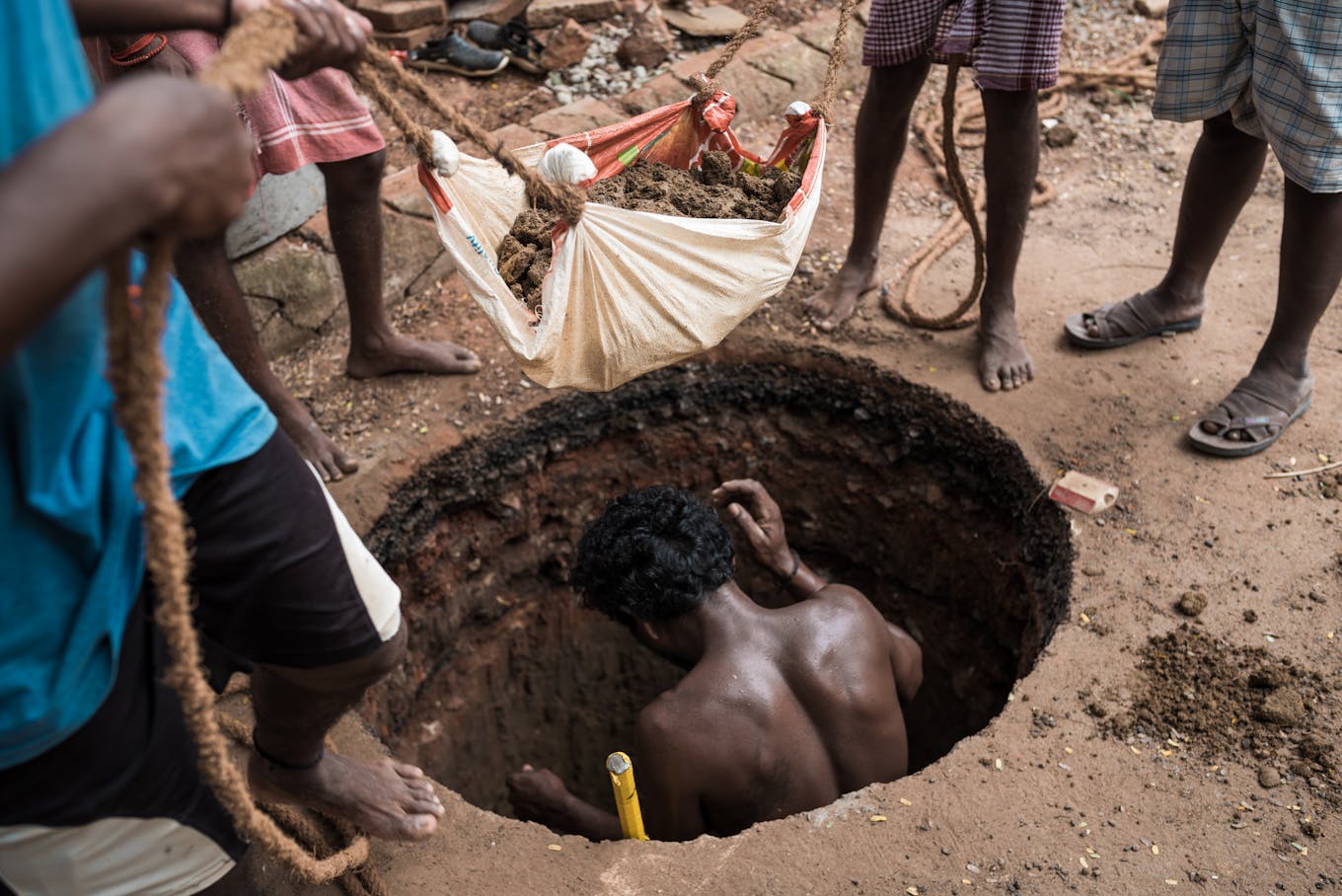
Residents in south Chennai dig a well to collect rainwater and recharge the city’s depleted groundwater. Image: Tim Ha, Eco-Business
There are signs the government has recognised that certain missteps must be remedied. For instance, efforts are underway to manage resources more responsibly, with recycled water now supplied to big industrial clusters on the city’s northern and western fringes after two new treatment plants became operational last October.
Increasingly, authorities are also heeding calls to rethink drainage systems, Ramachandran told Eco-Business. Recharge wells are being built across the city to allow rainwater to reach drained aquifers, although many lament that progress is moving at a snail’s pace.
Meanwhile, Chennai River Restoration Trust, the government agency responsible for the rehabilitation of the city’s streams, intends to lay pipelines and build treatment plants to divert sewage even as it investigates illegal wastewater outlets. It is even building a fence along Adyar River to prevent illicit waste dumping.
However, many of Chennai’s pollution problems persist while amid the coronavirus pandemic efforts to dredge up waste along rivers have come to a standstill. Most reservoirs are still being poorly maintained, and the issue has become so big that the state does not have the funds to address it, Vencatesan told Eco-Business. The city also has yet to revive its much-touted rainwater harvesting scheme.
If Chennai took a more holistic approach, it could become a water-secure city within a few years, said Ramachandran. This means taming its real estate sector, holding polluters to account and installing water treatment plants everywhere. It also means providing reliable piped water supply to rein in reckless groundwater extraction and choke off the parallel water economy.
Beyond that, greening strategies and rooftop gardens could ensure rainwater is better captured, while support for rural areas through farm-to-table programmes could help farmers get rid of voracious middlemen. This would improve rural incomes and ensure families don’t fall prey to water traders.
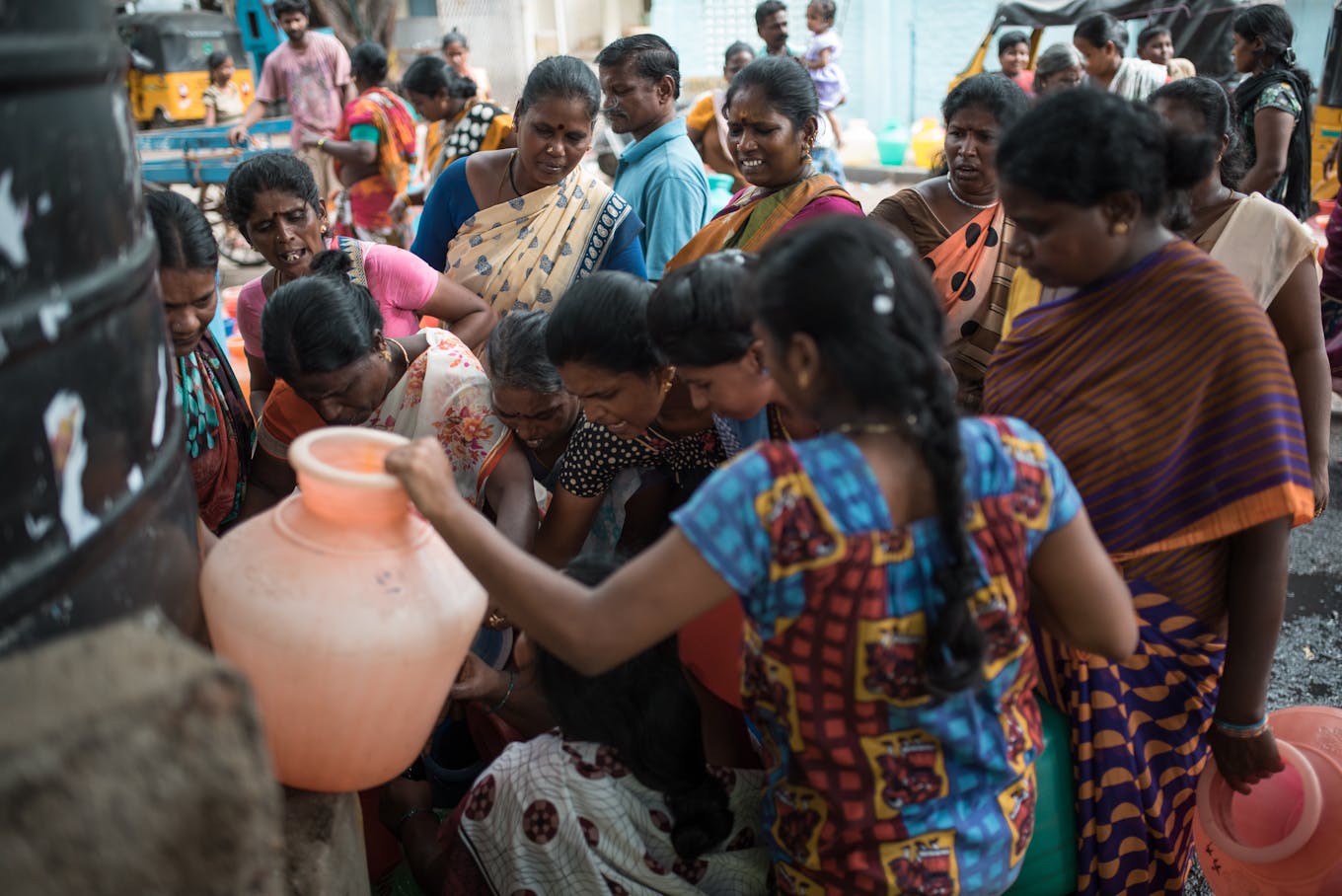
Residents fight over water in Dhasaprakash, a neighbourhood in Chennai, in August 2019. Image: Tim Ha, Eco-Business
Despite the current respite, Chennai’s situation remains fragile. But as climate change kicks into higher gear in the decades ahead, things will only get worse.
The city is already hotter than before, yet the most pressing concern is that dry years could become drier, and wet years wetter. Researchers have observed a decline in monsoon precipitation since the 1950s, even as the frequency of heavy rainfall events has increased. And as sea levels rise, saltwater threatens to push further inland and intrude into drained aquifers, rendering groundwater undrinkable.
“We are very concerned. We would like the city to respond to these threats more quickly, but knowing the constraints Chennai has, we know that expectation is not realistic,” said Vencatesan. If progress on tackling its water problems remains patchy, the city may grapple with scarcity for decades to come. Chennai has yet to realise just how vulnerable it is, she observed.
“When people see rain, and they start getting piped water supply again, they forget about droughts. The government has not learned. People have not learned. Their memory is very short. Once the rains start coming, the memory is wiped,” Sekhar Raghavan, director at Chennai-based non-profit organisation Rain Centre, and an outspoken supporter of better rainwater harvesting, told Eco-Business last year.

